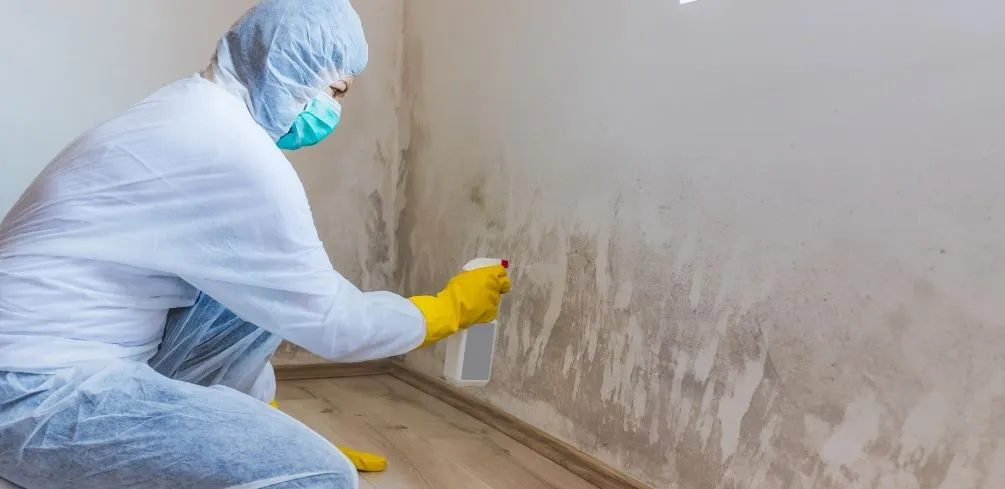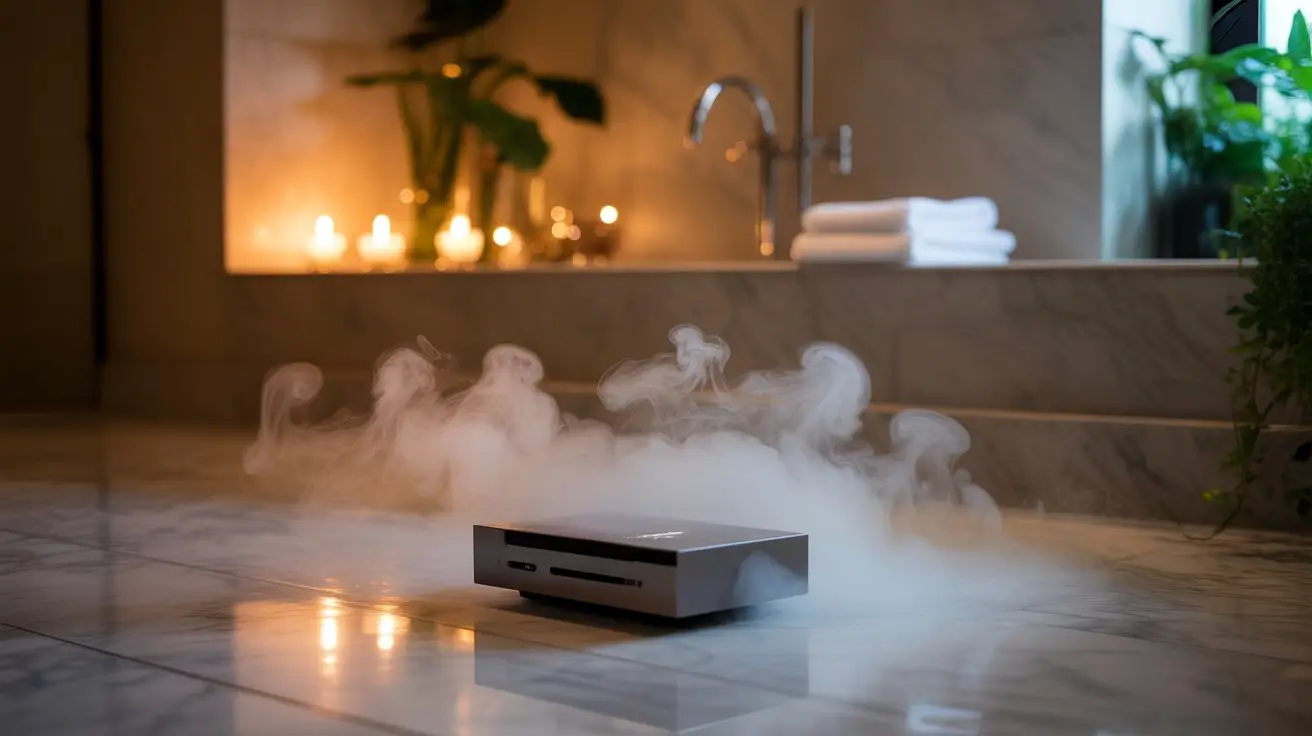No, dry fogging does not remove mold. It only removes the surface mold and leaves behind the expansive root system. The system root is what allows mold to continue to grow and spread. Dry fogging also does not kill mold spores, which are the reproductive system of mold that allows it to spread quickly.
In this blog post, I will explore the effects of dry fogging on mold. I will explore the effectiveness of dry fogging for mold removal and answer some common questions about the process.
What is Dry Fogging?
Dry fogging is a cold sterilization process that uses a fog of chemicals to sanitize surfaces. It is a mold removal process that uses a machine to generate a fog of tiny particles.
This fog is then sprayed into the affected area. The small particles in the fog attach to mold spores and other contaminants on surfaces and in the air.
Dry fogging is often used in commercial and industrial settings, as it is a quick and effective way to sanitize large areas. It is also sometimes used in homes.
The usage is regulated by the Environmental Protection Agency (EPA) and the Occupational Safety and Health Administration (OSHA). They do not recommend using dry fogging in homes unless it is done by a professional.
How Does Dry Fogging Work?
It works by using a machine to generate a fog of tiny particles. These particles are then sprayed into the affected area.
The particles in the fog attach to contaminants on surfaces killing the mold that is on the surface.
A mold fogger produces a fog or mist of very fine droplets. The size of the droplets is usually between 0.008 and 150 microns.
A micron is a unit of measurement equal to one-millionth of a meter.
The mold fogger releases the fog into the air. The fog settles on surfaces and penetrates deep into nooks and crannies where mold can hide.
Fogging is an effective do-it-yourself mold removal solution for small areas. It, however, does not prevent mold from growing back, nor does it clear away the actively growing mold because the root of the problem is yet to be dealt with.
The time it takes to eliminate the molds depends on the type of machine used, the size of the room, and the number of air changes per hour. The average time it takes to fog a room is about 30 minutes.
Does Dry Fogging Work for Mold Removal?
Dry fogging can remove mold from surfaces, but it does not kill mold spores in the air. It is also important to note that dry fogging does not remove the root system of the mold.
This means that the mold will likely grow back after dry fogging.
Dry fogging is a temporary solution to a problem that requires a permanent fix. If you have a mold problem, you should address the cause of the mold growth.
This could be a moisture problem in your home. Once the source of the moisture is handled, you can then take steps to remove the mold and prevent it from growing back.
Consider fogging after you have taken the following steps:
- Remove the source of moisture
- Ventilate the affected area
- Clean and dry all surfaces
- Apply an EPA-registered fungicide to surfaces
Dry fogging can be an effective tool in your mold removal arsenal, but it should not be your only method. Use it in conjunction with other mold removal methods to achieve the best results.
Contact a professional mold removal company to discuss your options if you have a mold problem. A professional mold removal company will be able to assess your situation and recommend the best course of action.
Why Does Dry Fogging Not Work for Mold Removal?
There are several reasons why dry fogging does not work for mold removal.
- It does not consider the actual cause of the problem– When you use dry fogging to remove mold, you are not addressing the cause. Mold grows because there is too much moisture in the air. Dry fogging does not remove the source of the moisture. This means that the mold will likely grow back after dry fogging.
- It only removes surface mold– When you use dry fogging to remove mold, you only remove the surface mold. Dry fogging does not penetrate deep into surfaces to remove the root system of the mold. This neglects the correct source of the problem and can quickly cause the mold to come back.
- It does not kill mold spores in the air– Dry fogging only removes mold from surfaces. It does not kill mold spores in the air. This means that the mold can continue to spread through your home or business after dry fogging.
- It is a temporary solution– By not addressing the cause of the problem and the structural degradation that often comes with mold, dry fogging is only a quick solution. The mold will continue to grow, and the structure will continue to degrade without a permanent fix.
What Kind of Fogging Works for Mold Removal?
Thermal Fogging
Thermal fogging uses a heat source to create a dense fog that penetrates deep into surfaces. It generates a lot of fog that fills the whole room.
Fogging reaches hard-to-reach places like cracks and crevices throughout the house and its contents, including hard-to-reach surfaces, beneath furniture, rugs, and draperies. Thermal foggers are both safe and effective.
The fogger may also be activated remotely, enabling the fog to spread organically over space and into open cabinets and drawers before dissipating over time.
ULV Fogging
ULV (ultra-low volume) foggers use a small number of chemicals to generate a large amount of fog. The tiny droplets of fog created by ULV foggers can penetrate deep into surfaces and kill mold spores.
Electrostatic Foggers
Electrostatic Foggers charge the particles in the fog so that they stick to surfaces. This enables the fog to evenly coat all surfaces in a room, including hard-to-reach places.
Electrostatic foggers are effective at removing mold and preventing it from coming back.
Chemical Fogging
Chemical fogging uses chemicals to create a dense fog that penetrates deep into surfaces. They produce a very fine fog that clings to surfaces and kills mold spores on contact.
Ultrasonic Foggers
Ultrasonic Foggers create a fine mist that penetrates deep into surfaces and kills mold spores on contact.
Do Mold Foggers Work?
Mold foggers can be effective in mold removal if used correctly. It is essential to follow the manufacturer’s instructions when using these foggers.
When appropriately used, thermal fogging, ULV fogging, electrostatic fogging, chemical fogging, and ultrasonic fogging can all effectively mold removal.
Each type of fogger has its advantages and disadvantages. It is important to choose the right type of fogger for your needs and follow the manufacturer’s instructions carefully to avoid health hazards and damage to your home or business.
Final Thoughts
Mold fogging is a temporary solution that does not address the cause of the problem. Choosing the right type of fogger for your needs is important, and follow the manufacturer’s instructions carefully.
Thermal fogging, ULV fogging, electrostatic fogging, chemical fogging, and ultrasonic fogging can be effective in mold removal. I hope this article has answered any questions you have on whether dry fogging works for mold removal.
Please be careful and use at your own risk
None of the authors, contributors, administrators, or anyone else connected with Wild Fog, in any way whatsoever, can be responsible for your use of the information contained in or linked from these web pages.










